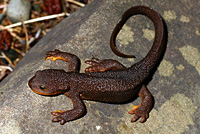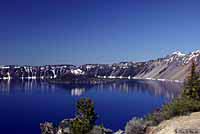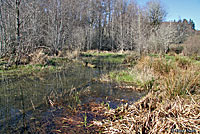
Pacific Northwest
Reptiles & Amphibians
Click on a picture for a larger view
Rough-skinned Newt - Taricha granulosa
(Skilton, 1849)
Related or Similar Northwest Salamanders:
Northwestern Salamander
 |
 |
 |
| Adult, Grays Harbor County, Washington | ||
 |
 |
 |
| Adult underwater, Douglas County Oregon |
Adult, underwater in a small pool at the edge of a river, Douglas County Oregon | Adult in a pond, Mason County, Washington |
 |
 |
 |
| Adults in a pond, Thurston County, Washington |
Adult in a pond, Thurston County, Washington |
Adults in a pond, Thurston County, Washington |
 |
 |
 |
| Adult in a pond, Thurston County, Washington |
Adult in a pond, Thurston County, Washington |
Recently metamorphed juvenile, Oregon |
 |
 |
 |
| Adult, Mason County, Washington | Rough-skinned Newts have a dark lower eyelid. The eye has a yellow patch in it. | |
 |
 |
 |
| From above, the eyes do not reach the outline of the head. | Rough-skinned Newt Skeleton National Museum of Natural History |
|
 |
 |
|
| Adult, breeding aquatic phase, Pacific County, Washington |
Large mass of adult newts underwater in early September, southern Oregon There are aprox. 2000 newts in this mass, according to David Mikkelsen. He has observed that after the spring breeding season the newts congregate in underwater leaf litter in the shaded still water at the edge of this river and stay there until the beginning of the fall rains when they once again return to the surrounding forest. |
|
| Defensive Posture | ||
 |
 |
 |
| Adult, Lewis County, Washington This newt is in a defensive posture called "unkenreflex"in which it displays its brightly-colored underside as a warning. The Rough-skinned newt curls it's colorful tail. Compare with the straight tail of the sometimes sympatric California Newt and the sometimes sympatric Sierra Newt. |
||
 |
 |
 |
| Adult in defensive posture, Douglas County Oregon. (Note that this newt is not curling its tail over the back, which is the typical behavior for this species.) |
||
| Aberrant Newts | ||
 |
 |
 |
| This unusual Rough-skinned Newt with a light ground color and dark blotches, was found near the coast in Tillamook County, Oregon in an area with many other typically-colored newts. © Matt D'Agrosa and Yvonne Stotler | This is a short video of the newt described to the left. © Matt D'Agrosa and Yvonne Stotler |
|
| Newts Feeding | ||
 |
 |
 |
| Several adult newts in a Pacific County, WA breeding pond in late February eating the eggs of another amphibian, probably Northwestern Salamander or Western Long-toed Salamander eggs. | ||
 |
 |
 |
 |
 |
 |
 |
 |
|
| The eight pictures above show several Rough-skinned Newts eating earthworms on a road at night in Marion County, Oregon. They were among more than a thousand adult female newts that had migrated out onto the road on two rainy nights in late January & early February to take advantage of the worms which had crawled onto the road. The females were feeding before heading to the breeding pond, which was already full of males awaiting their arrival. © Chris Rombough | ||
| Breeding, Eggs, and Young | ||
 |
 |
 |
| Underwater male and female in amplexus, Pacific County, Washington | Mating ball, Southwest Oregon, © Steven Krause |
Male and female in amplexus, Pacific County, Washington |
 |
 |
 |
| During the breeding season, adult males develop nuptial pads on the toes to improve their ability to hold onto females during amplexus. Compare with the toes of a breeding female without these pads. | Egg on submerged blade of grass, Thurston County, Washington. © 2004 William Leonard |
Gilled metamorph found on land and photographed underwater. |
 |
 |
|
| Larva (in water) | Larva (in water) | |
 |
 |
|
| Larva (in water) | Larva (in water) | |
 |
 |
 |
| Metamorphs, found on land at the edge of a pond, and photographed underwater. Notice the trace of gills remaining | ||
| Habitat | ||
 |
 |
 |
| Habitat, Douglas County, Oregon | Breeding pond, Benton County, Oregon | Breeding pond, Pacific County, Washington |
 |
 |
 |
| Breeding pond, Thurston County, Washington |
The newts at Crater Lake, Klamath County, Oregon, are dark sometimes with dark undersides. Some herpetologists recognize them as a different subspecies:Taricha granulosa mazamae - The Crater Lake Rough-skinned Newt. | Habitat, Grays Harbor County, Washington |
 |
 |
 |
| Habitat, Kitsap County, Washington | Breeding pond, Pacific County, Washington |
Breeding pond, Pacific County, Washington |
 |
 |
 |
| Breeding pond, Pacific County, Washington |
Habitat, Thurston County, Washington | Habitat, Thurston County, Washington |
 |
||
| Habitat, Mason County, Washington | ||
| Short Videos | ||
 |
 |
 |
Rough-skinned newts move around the rocky shallow margins of a river in Douglas County, Oregon, occasionally coming up for air. |
A few light taps on the back of a Rough-skinned Newt causes it to take a passive defensive posture, raising its tail and head to display the bright orange color of its underside which signifies danger. This "unken reflex" shows a would-be predator that the newt is deadly poisonous, while at the same time, the newt releases deadly toxins from its skin. | Pairs of Rough-skinned newts in amplexus in the breeding pond. |
 |
 |
 |
| A male and a female Rough-skinned newt in their underwater amplexus ballet. | Male newts in the breeding pond wrestling over and waiting for females. | Solo male newts and males and females in amplexus swim underwater in a breeding pond in Pacific County, Washington in mid February. |
 |
 |
|
| This short video shows several Rough-skinned newts in a Tillamook Co., Oregon coastal lake, 3.5 feet offshore and in 12" deep water feeding on largemouth bass eggs, most less than 1 mm in diameter. Male largemouth bass construct a nest where the female lays her eggs. It is often a circular depression in the substrate or a patch of submerged vegetation. In this case the nest is the patch of moss in which we see the newts, and the eggs are sticking to the strands. © Chris Rombough |
Several Rough-skinned newts in Pacific County, Washington, interact with an underwater egg mass that could be from A. gracile - Northwestern Salamander, or possibly a Long-toed Salamander. Some of the newts appear to be trying to bite the eggs as if to eat them, while others seem to just thrash around without taking any bites. | |
Northwest Reptiles and Amphibians
Return to the Top
© 2000 -
